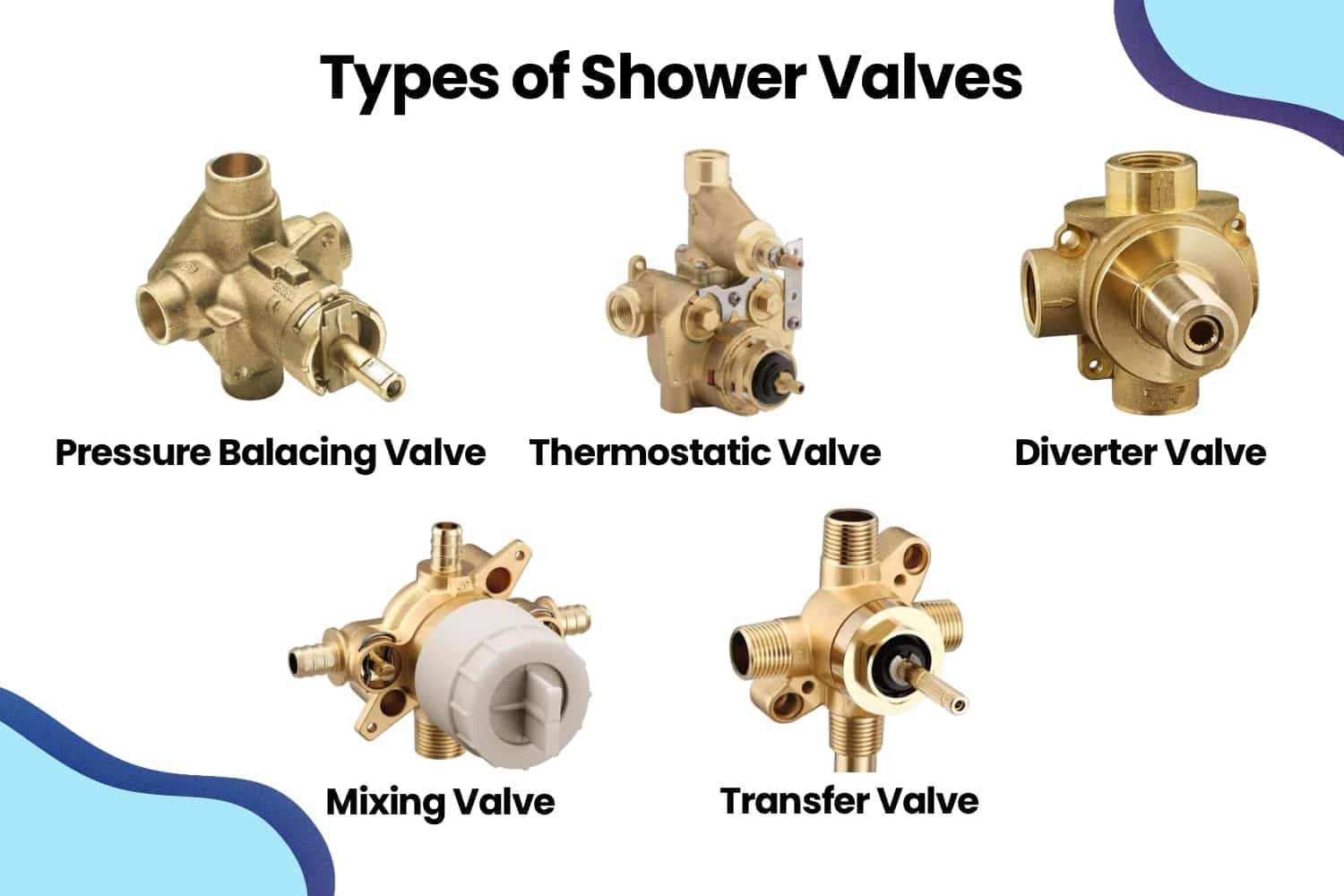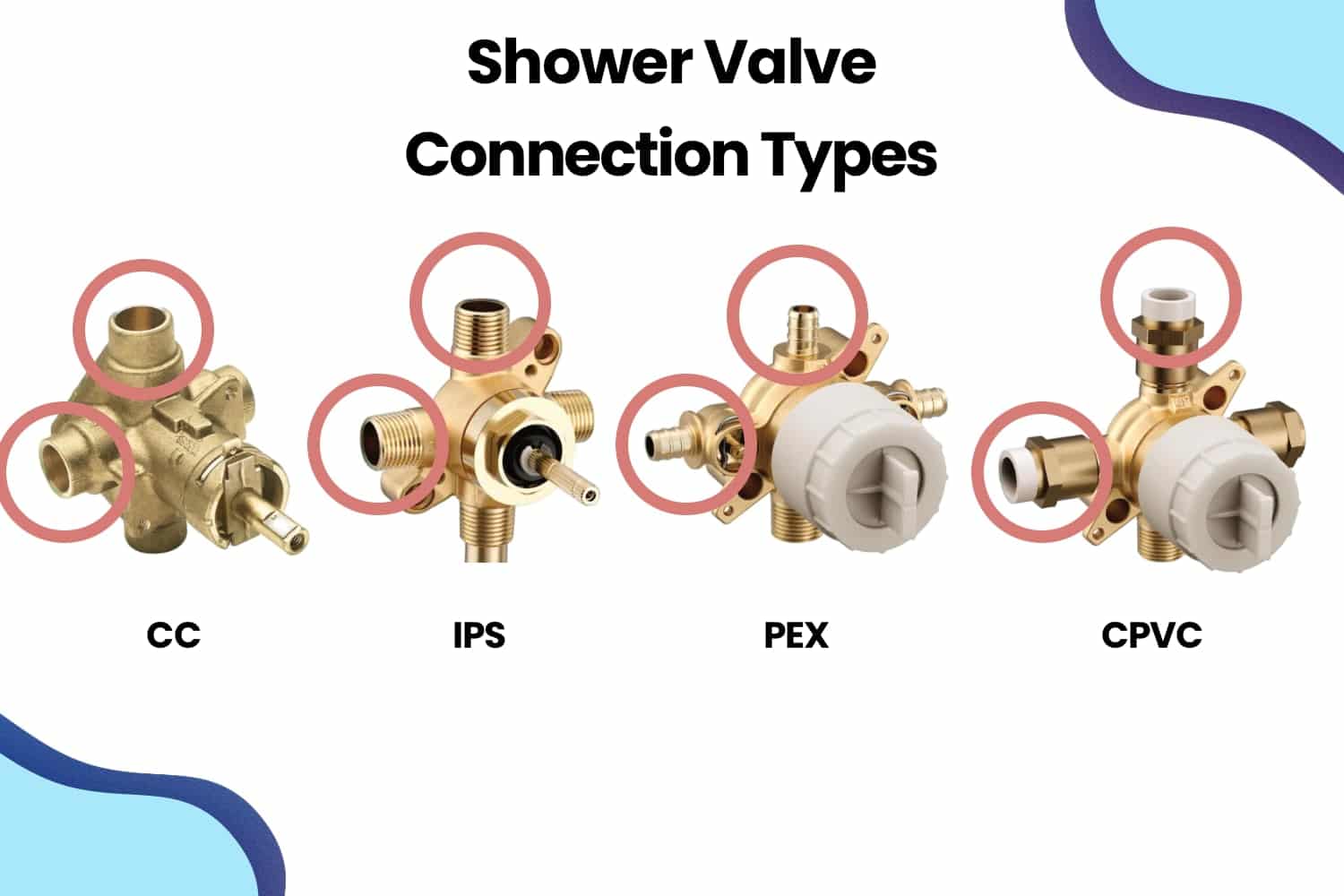Controlling the temperature and flow of water to your shower head is a valve. Normally resting behind the escutcheon plate, the shower valve is a critical component of any shower system.
However, shower valves differ in their design, connection, and compatibility. We’ll highlight all of this to help deepen your understanding of the different types of shower valves.

Pressure Balancing Valves
Pressure balancing valves are the most common valve type. As the name suggests, pressure balancing valves regulate both the water pressure and temperature of water flowing to the shower head to prevent sudden changes in temperature.
Per the International Residential Code (IRC), pressure balancing valves are required to be installed on all new shower systems (source – P2708.4). Unlike previous valves, pressure balancing valves prevent scalding hot water from running through the shower head when other fixtures, namely a toilet, are used.
The piston within the valve is susceptible to wearing out. While the pressure balancing valve may last for several years before requiring replacement, hard water may shorten its lifespan due to mineral and sediment buildup.
One notable drawback to the pressure balancing valve is that you cannot control the volume of water exiting the shower head. It is an on/off design, which may not work for some folks who have children or pets who may be scared by the volume of water.
Thermostatic Valves
The thermostatic valve regulates temperature through a thermostat. This allows the person showering to get pinpoint accuracy when setting the temperature of the water. Showers that have a thermostatic valve will usually have one handle for temperature and another to control the flow of water. This valve offers the most versatility of all others currently available.
Twin and triple thermostatic valves provide greater control should you have multiple shower heads within the same shower system. These valve types allow you to control the flow of water between shower heads and the entire system. A diverter may be added to the valve extending functionality further for body sprays and other shower accessories.
Diverter Valves
To support tub and shower combinations, a diverter valve is required. A diverter valve redirects the flow of water from the bathtub faucet to the shower, typically by lifting up the tee diverter. Other diverter valves include twin and triple valve diverters to independently control the temperature and directional flow of water to either the shower head or tub spout.
Transfer Valves
A transfer valve redirects the flow of water from one shower head to another. You’ll find transfer valves on dual handheld shower heads near the connection point on the primary shower head and the shower arm. This valve does not regulate temperature or flow; it simply redirects or transfers the flow of water from one shower head to another.
Mixing Valves
Previous to the introduction of pressure balancing valves, mixing valves were the standard. These valves blend the hot and cold water together. Mixing valves do not contain any sort of thermostat or piston to regulate pressure from the hot and cold lines, which may result in drastic changes in temperature. These valves are found in older homes and should be replaced with a modern valve when possible.
Connection Types (CC, IPS, PEX, CPVC)

Shower valves are available in a variety of connection types which include copper connections (CC), threads (IPS), PEX, and CPVC.
- Copper Connections (CC): Shower valves marked with a CC inlet and outlet connections must be soldered into place.
- IPS Connection: A IPS connection adheres to the National Pipe Thread (NPT) standard. With a 1/2″ diameter, a shower valve with this connection type screws into place.
- PEX Connection: PEX refers to cross-linked polyethylene. A shower valve with a PEX connection will connect to rubber or plastic tubing using crimp rings or clamps.
- CPVC Connection: CPVC refers to a chlorinated polyvinyl chloride fitting. Plastic tubing connects directly to the valve using a CPVC connection.
Does the brand of shower valve matter?
Whether you are installing a new shower valve, replacing a broken one, or need to upgrade to a pressure balancing valve, we recommend purchasing from a reputable brand such as Moen, Delta, or Kohler. These brands offer limited lifetime warranties on their products and are backed by a large network of service centers. Additionally, when you eventually need to change the cartridge, the brand will likely have a replacement cartridge available, and the fit will be exact to ensure proper function.
What does “rough in” mean?
As you shop for a new shower valve, you may notice the term “rough in” used to describe the valve. Rough in refers to the piping work that is done behind the walls and is eventually connected to the visible components or fixtures. Shower valves are a part of the rough in plumbing work that connects to the eventual shower fixtures.
